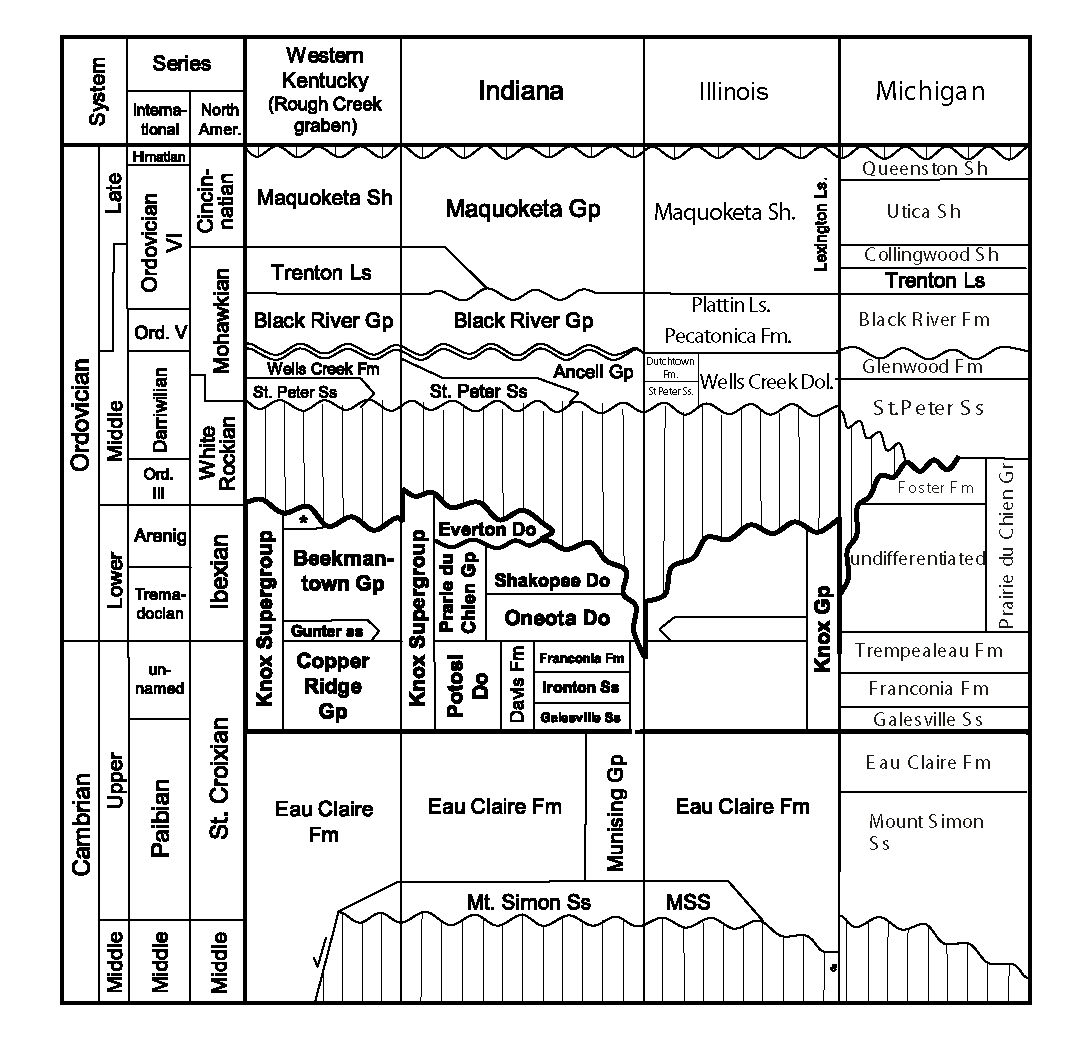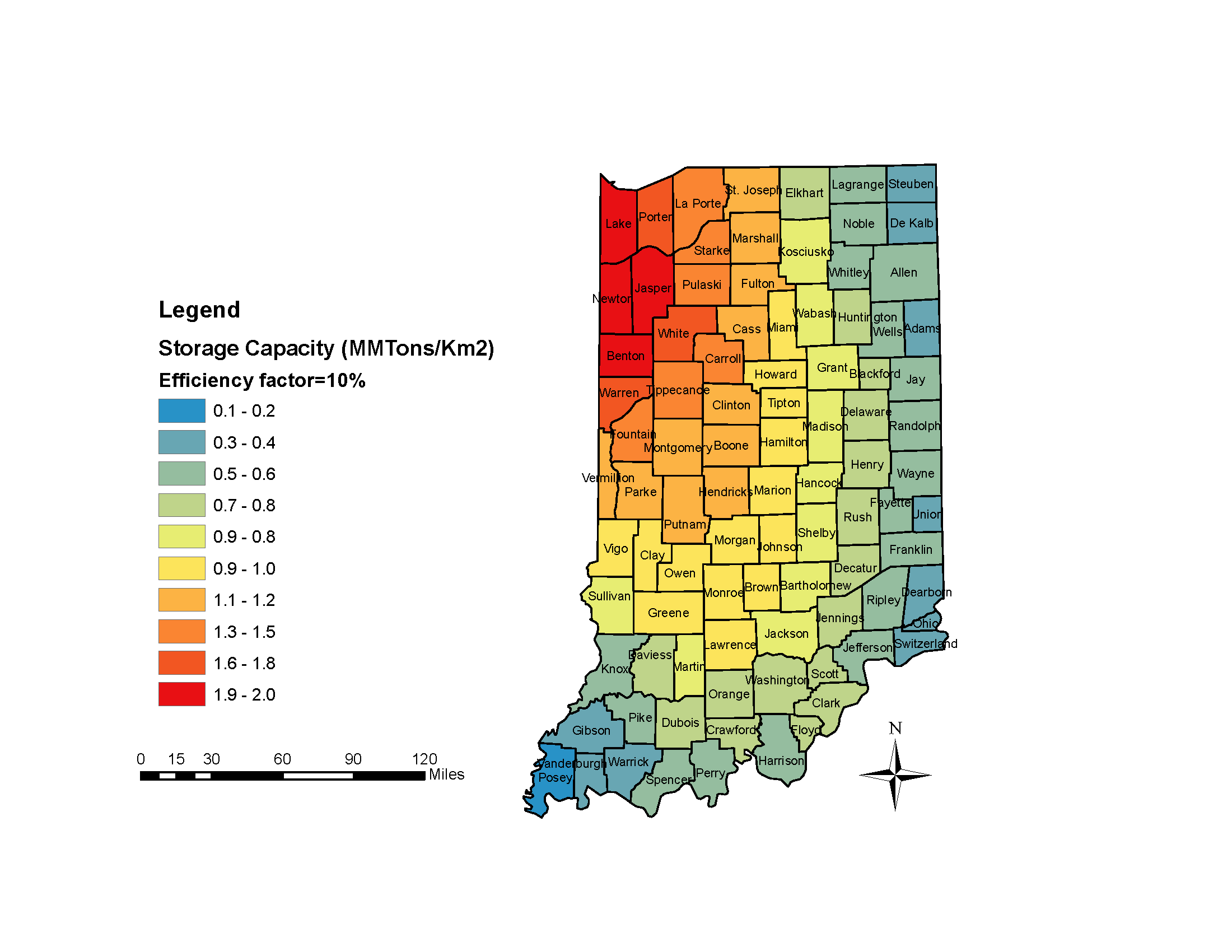
Figure 1.
Regional stratigraphic correlations of the Cambrian and Ordovician systems.
Click to view full chart
(modified from Greb et al., 2009).
Indiana produces a great deal of energy, and approximately 70 percent of the state's CO2 emissions from stationary sources are produced from coal-fired power plants (NATCARB, 2011). As a result, geologic carbon capture and storage (also known as carbon sequestration) may be a promising technology for Indiana to reduce its CO2 emissions to the atmosphere. Carbon sequestration in underground geologic formations may be conducted in depleted oil and gas reservoirs, coal beds, or deep saline formations. The latter are particularly attractive in Indiana because of the distribution of these potential storage reservoirs in the subsurface and their favorable geologic characteristics. The main target reservoir identified for this purpose is the Upper Cambrian Mount Simon Sandstone, which is overlain conformably by relatively impermeable layers of the Cambrian Eau Claire Formation, a unit identified as a regional confining zone (also called caprock) in the Midwest (fig. 1).
The depth of the Mount Simon Sandstone is variable across Indiana, and ranges from less than 2,500 feet in northwest Indiana to more than 13,000 feet in southwest Indiana (fig. 2). The thickness of the Mount Simon Sandstone ranges from less than 400 feet in eastern Indiana to nearly 2,500 feet as it approaches its thickest accumulation in northwestern Indiana (fig. 3). For reasons of efficiency and safety, CO2 is stored at depths greater than 2,500 feet because its density is known to increase substantially at these depths, allowing greater quantities of CO2 to be stored in deeper formations.*

Figure 2.
Depth measured from ground surface to the top of the Mount Simon Sandstone. (click to enlarge)

Figure 3.
Thickness map of the Mount Simon Sandstone. (click to enlarge)

Figure 4.
Storage capacity of the Mount Simon Sandstone calculated by county using an efficiency factor of 10 percent (ξ =0.1). (click to enlarge)
To estimate CO2 sequestration potential volumes in deep saline formations, knowledge of basic reservoir parameters such as porosity and density of the supercritical fluid of CO2 are required. The calculation was done according to the following equation (US DOE, 2008; Medina, 2011):
SC = hn * øn * ρCO2 * ξ
where SC = CO2 storage capacity in metric tons per unit of area; hn = net thickness (ft); øn = net average porosity (dimensionless); ρCO2 = CO2 density (roughly 47 lb/ft3); and ξ = storage efficiency (ξ =0.1 or 10%, figure 4), which is estimated by multiplying a combination of volumetric and reservoir performance parameters that reflect what portion of the subsurface will actually be occupied by carbon dioxide and how that CO2 will move through the reservoir. The volumetric portion of ξ takes into account three factors: net area to total area (area in the basin that has a suitable formation for injection), net thickness to gross thickness, and effective porosity to total porosity. These preliminary estimates of carbon dioxide storage capacity suggest that the highest potential occurs where the Mount Simon Sandstone is thicker and shallower (figure 4).
* A sentence was deleted from this abstract on Oct. 9, 2023, concerning the broad ability of the Mount Simon sandstone "in northwestern Indiana" to viably sequester and contain CO2. Due to detailed studies now occurring in the area, the IGWS can no longer support the statement that was deleted; it had been based on modeling that occurred in the early to mid-2010s and is now outdated.References
Greb, S., Harris, D. C., Solis, M. P., Anderson, W. H., Drahovzal, J. A., Nuttall, B. C., Riley, R. A., Solano-Acosta, W., Rupp, J. A., and Gupta, N., 2009, Cambrian-Ordovician Knox carbonate section as integrated reservoirs and seals for carbon sequestration in the eastern mid-continent United States, in Grobe, M., Pashin, J., and Dodge, R. L., eds., Carbon dioxide sequestration in geologic media - state of the science: Tulsa, Okla., American Association of Petroleum Geologists, p. 241-259.
Medina, C. R., Rupp, J. A., and Barnes, D. A., 2011, Effects of reduction in porosity and permeability with depth on storage capacity and injectivity in deep saline aquifers - a case study from the Mount Simon Sandstone aquifer: International Journal of Greenhouse Gas Control, v. 5, p. 146-156.
National Carbon Sequestration Database and Geographic Information System (NATCARB), U.S. Department of Energy (DOE) National Energy Technology Laboratory (NETL), 2011, NATCARB Web site, <https://www.netl.doe.gov/coal/carbon-storage/strategic-program-support/natcarb-atlas>, date accessed, March 11, 2011.
USDOE (U.S. Department of Energy), 2010, Carbon sequestration atlas of the United States and Canada, 3rd ed.: National Energy Technology Laboratory Web site, 160 p. <https://openei.org/wiki/2010_Carbon_Sequestration_Atlas_of_the_United_States_and_Canada:_Third_Edition>, date accessed, March 11, 2011.


